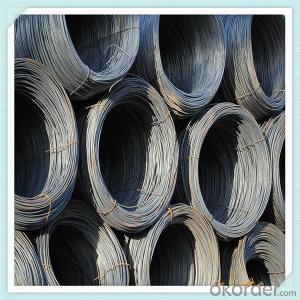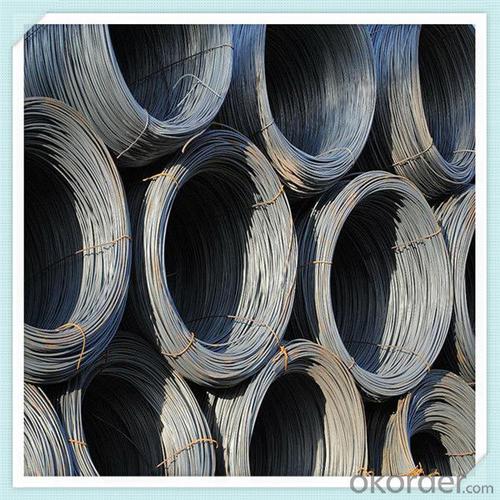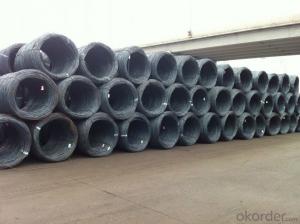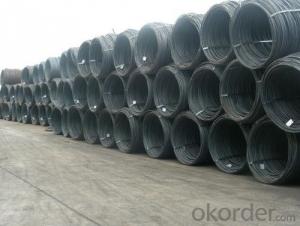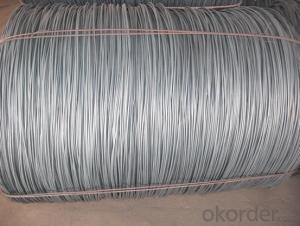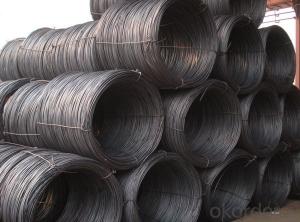SAE1012 5.5-14MM Steel wire rod hot rolled
- Loading Port:
- Shanghai
- Payment Terms:
- TT OR LC
- Min Order Qty:
- 100 m.t.
- Supply Capability:
- 14500 m.t./month
OKorder Service Pledge
OKorder Financial Service
You Might Also Like
Specification
Features
1、Pure steel quality, stable chemical contents, small tolerance.
2、Constant Quality, good drawing performance.
3、High dimension accuracy degree, accuracy degree of Level C up to 80%, smooth surface, less scale,
easy to be pickled.
4、Automatic bundling with 4 lines by Machine in tidy and good looks
5、Big high quality percentage, small coil percentage, and heavy coil weight for Hard Coil.
6、High sorbitizing percentage.
Drawing Grade wire rods are used by downstream industries for various applications such as making
wires for welded mesh, nails, hangers, screws, chain link & gabion fencing, wire nets, barbed wires
and binding wires.
Product Description :
Standard | AISI, ASTM, BS, DIN, GB, JIS |
Material/steel grade | Q195-Q235,SAE1006B,SAE1006CR, SAE1008B, SAE1008CR, SAE1010B, SAE1018B, or according to customers requirements |
Wire Gauge | 5.5-12mm |
Coil weight | 1.8-2.1mts |
MOQ | 25MT |
Delivery Time | 15-30 days after receipt of L/C or deposit by T/T |
Packing | In coil and load in container, if large quantity, by bulk vessel; Can be packed as customers' special requirements |
Payment terms | 1).100% irrevocable L/C at sight. 2).30% T/T prepaid and the balance against the copy of B/L. 3).30% T/T prepaid and the balance against L/C |
Application | widely used in machinery parts, manufacturing industry, electronics industry, metal tools and others |
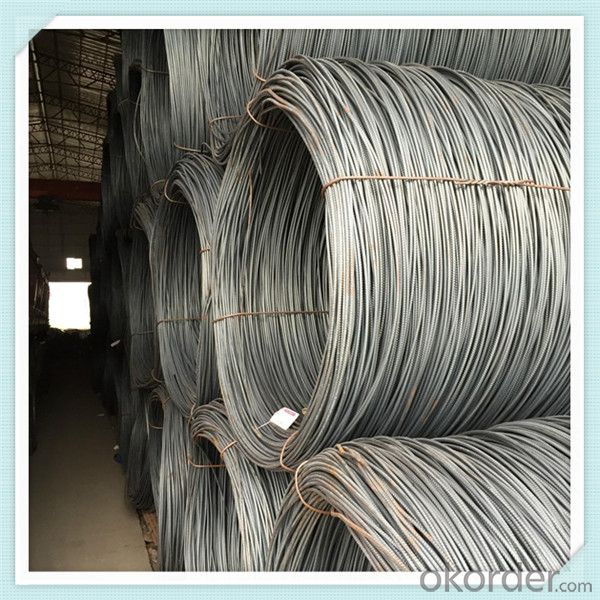
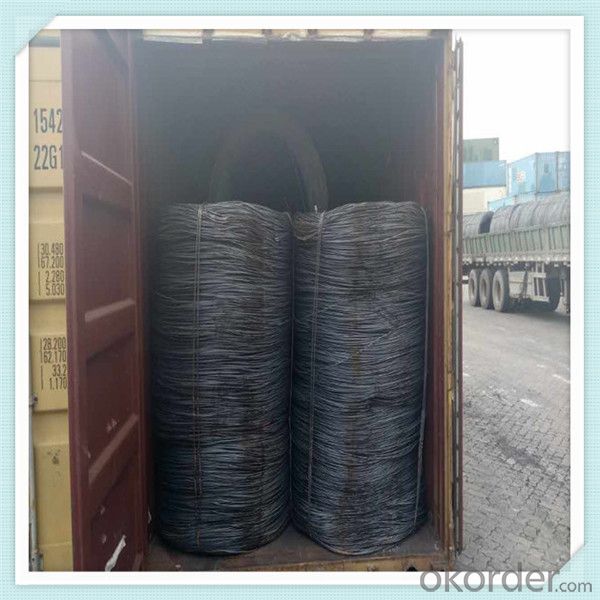
Application :
It generally used in braiding the hose for bathing product and machinery. With it
good flexibility, resistant to high temperature and resistant to corrosion, it
used widely in many industries.
Packing :
Hot-rolled wire rod is held in a unit with at least four steel straps in the
transverse direction and transported and stored without further packaging.
Before
the steel strapping is applied, the wire rod must be sufficiently compressed.
The strapping is fixed in the transverse direction with a single circumferential
strap so that the strapping does not slip and cause the coil to come apart.


Our service:
(1) We cooperate with famous factories with advanced equipment and well trained workers.
(2) We can provide factory price with trading company service.
(3) We continuously work on the improvement of our processes, guaranteeing
consistently high standards of quality to keep none compensation.
(4) We guarantee 24 hours response and 48 hours solution providing service.
(5) We accept small order quantity before formal cooperation.
(6) We deliver the agreed quality at the agreed time, reacting to changes in
customer wishes in a flexible way.
(7) Due to our volume and selling power, we have excellent freight rates with
shipping lines.
(8) We strive to always be fair and honest in our dealings with customers.
(9) We strive to work together with customers to achieve much more than we can
achieve alone.
(10) Through our passion and commitment we aim to be a market leader in all our
key markets. To maintain our position as market leader we must continue to add
value in all that we do.
FAQ:
1.Q: What's your MOQ(minimum order quantity)?
A: One full container, mixed acceptable .
2. Q: What's your packing methods?
A: Packed in bundle or bulk ..
3. Q: How can I buy CNBM products in my country?
A:Please send us an inquiry or email ,we will reply to you if there is distributor in your country
4. Q: Can we visit your factory?
A: Warmly welcome. Once we have your schedule, we will arrange the
professional sales team to follow up your case.
5. Q: How long does it take to get the product if i place an order?
A:With the process of your requirements,we will pack and deliver in 3
-7 days. If it is by sea shipment,it will take 15-45 days depending on different locations
- Q: What are the main factors affecting the wear resistance of steel wire rod?
- The main factors affecting the wear resistance of steel wire rod are the composition and microstructure of the steel, the heat treatment applied to the rod, the surface finish of the rod, and the operating conditions such as load, speed, and lubrication.
- Q: How is steel wire rod used in the manufacturing of wire ropes for cranes?
- Steel wire rod is used as the primary material in the manufacturing of wire ropes for cranes. It undergoes a series of processes such as drawing, stranding, and coating to transform it into a strong and durable wire rope. The steel wire rod provides the necessary tensile strength and flexibility needed to lift heavy loads and withstand the demanding conditions of crane operations.
- Q: What are the different machinability testing methods for steel wire rod?
- There are several machinability testing methods available for steel wire rod. Some of the common methods used in industry include: 1. Turning Test: This method involves machining the steel wire rod using a lathe or turning machine. The cutting parameters such as cutting speed, feed rate, and depth of cut are varied to evaluate the machinability of the material. The tool wear, surface finish, and chip formation are observed and analyzed to assess the machinability characteristics. 2. Drilling Test: In this method, a drilling machine is used to create holes in the steel wire rod. The drilling parameters such as cutting speed, feed rate, and drill geometry are adjusted to determine the machinability. The hole quality, chip formation, and tool wear are examined to evaluate the performance of the material during drilling. 3. Tapping Test: Tapping is a common machining operation performed on steel wire rods to create threaded holes. In this test, the steel wire rod is tapped using a tapping tool. The torque required, tool life, and thread quality are assessed to determine the machinability of the material. 4. Grinding Test: Grinding is a precision machining process used to remove material from the steel wire rod. In this test, the steel wire rod is ground using a grinding wheel or abrasive belt. The grinding parameters such as grinding speed, feed rate, and grinding wheel specification are adjusted to evaluate the machinability. The surface roughness, material removal rate, and grinding wheel wear are analyzed to assess the performance of the material during grinding. 5. Hardness Test: Machinability can also be indirectly assessed by measuring the hardness of the steel wire rod. Hardness is an important mechanical property that affects the machinability of a material. Various hardness testing methods like Rockwell, Brinell, or Vickers hardness tests can be performed to determine the hardness of the steel wire rod. Higher hardness values indicate lower machinability, while lower hardness values suggest better machinability. These testing methods help manufacturers and engineers to select the most suitable machining parameters and tools for processing steel wire rods. By understanding the machinability characteristics, they can optimize the machining operations and improve productivity while minimizing tool wear and material waste.
- Q: How is steel wire rod used in the manufacturing of wire baskets for industrial applications?
- Steel wire rod is an essential raw material used in the manufacturing of wire baskets for industrial applications. The wire rod serves as the base material from which the wire baskets are formed. To begin the manufacturing process, the steel wire rod is first carefully selected and inspected for its quality and specifications. It is important for the wire rod to have the desired strength, flexibility, and durability required for industrial applications. Once the wire rod meets the necessary standards, it is then subjected to various processes to transform it into wire baskets. The first step in the manufacturing process involves drawing the steel wire rod through a series of dies to reduce its diameter and increase its length. This process is known as wire drawing. The wire drawing process helps in improving the wire rod's surface finish, strength, and dimensional accuracy. After wire drawing, the steel wire rod is then further processed through various techniques such as annealing, cleaning, and coating. Annealing helps to relieve any internal stresses in the wire and enhance its ductility, making it easier to form into wire baskets. Cleaning removes any impurities or contaminants from the wire rod's surface, ensuring a clean and smooth finish. Coating involves applying a protective layer on the wire rod to prevent corrosion and enhance its durability. Once the wire rod is prepared, it is ready to be formed into wire baskets. The wire rod is fed into a machine called a wire basket forming machine, where it is bent, twisted, and shaped into the desired basket design. The machine uses various mechanisms, such as rollers and dies, to mold the wire rod into the required shape and size. After the wire rod has been formed into wire baskets, they undergo further processes such as welding, cutting, and finishing. Welding is used to join the different sections of the wire basket together, ensuring its structural integrity. Cutting is performed to trim any excess wire and achieve the desired dimensions. Finally, the wire baskets are finished by removing any sharp edges, polishing the surface, and applying any required surface treatment or coating. In summary, steel wire rod plays a crucial role in the manufacturing of wire baskets for industrial applications. It serves as the primary material from which the wire baskets are formed, and its properties are vital in determining the strength, durability, and overall quality of the final product. Through a series of processes, the wire rod is transformed into wire baskets, which are then used in various industrial applications such as storage, transportation, and organization of goods.
- Q: How is steel wire rod used in the manufacturing of wire forms for window screens?
- The manufacturing of wire forms for window screens relies heavily on steel wire rod. This material serves as the fundamental element for constructing the wire mesh structure that makes up the screen. To start, careful consideration is given to the selection of the steel wire rod based on its quality and properties. The rod must possess specific qualities such as tensile strength, elasticity, and resistance to corrosion in order to ensure the durability and longevity of the window screen. Once the appropriate steel wire rod is obtained, it undergoes a series of manufacturing steps. Initially, the rod is thoroughly cleaned and then passed through a series of dies to reduce its diameter to the desired size. This process, known as wire drawing, is essential for achieving a finer wire that can be easily shaped into the desired form. Following wire drawing, the steel wire typically undergoes further processing through galvanization or coating. This step involves the application of a protective layer of zinc or other coatings to enhance the wire's resistance to corrosion and prolong its lifespan. The galvanized or coated wire is then subjected to additional processing to eliminate any excess coating and ensure a smooth surface. Ultimately, the processed steel wire is prepared for the formation of window screens. The wire is fed into wire forming machines, where it is shaped into the desired form, such as a rectangular or square mesh pattern. With great care, the wire is woven or welded together to create a robust and secure structure capable of withstanding external forces and effectively guarding against insects and debris. In conclusion, steel wire rod plays a vital role in the production of wire forms for window screens. It provides the necessary strength, durability, and resistance to corrosion required for a top-quality screen. Through various manufacturing processes, the steel wire rod is transformed into a finely drawn wire and then shaped into the desired form, resulting in a dependable and functional window screen.
- Q: How is steel wire rod used in the manufacturing of screws and bolts?
- Screws and bolts cannot be produced without steel wire rod, which is an essential element in their manufacturing process. This wire rod acts as the primary material from which these fasteners are made. To transform the steel wire rod into screws and bolts, a series of manufacturing procedures are carried out. Initially, the steel wire rod is subjected to a high temperature, causing it to soften. This process, known as annealing, increases the wire rod's malleability and makes it easier to handle. Once heated, the wire rod is then passed through a set of dies that shape it into the desired form. These dies are specially designed to create the thread pattern characteristic of screws and bolts. After the wire rod has been shaped, it is cut into appropriate lengths to produce individual screws and bolts. These lengths are further processed to incorporate essential features, such as the head shape and slot or recess for screwdrivers. In certain cases, the wire rod may also undergo treatment with various coatings or finishes to improve its durability and resistance to corrosion. The use of steel wire rod in the manufacturing of screws and bolts offers numerous advantages. Steel is well-known for its strength and durability, making it an ideal material for fasteners that must endure high levels of stress or tension. Additionally, steel wire rod is readily accessible and cost-effective, making it a popular choice for mass production. In conclusion, the significance of steel wire rod in the production of screws and bolts cannot be overstated. It acts as the starting material, which is then shaped and processed to create the final product. The utilization of steel wire rod ensures that screws and bolts possess the necessary strength, durability, and ability to fulfill their intended purpose in various applications.
- Q: What are the factors that influence the cost of steel wire rod?
- There are several factors that influence the cost of steel wire rod. 1. Raw material prices: The cost of steel wire rod is heavily influenced by the prices of raw materials, particularly iron ore and scrap metal. Fluctuations in these prices can significantly impact the cost of production and, subsequently, the price of steel wire rod. 2. Demand and supply dynamics: The demand for steel wire rod in various industries, such as construction, automotive, and manufacturing, can impact its cost. If there is high demand and limited supply, the price tends to increase. Conversely, if demand is low and supply is abundant, the price may decrease. 3. Production and manufacturing costs: The cost of producing steel wire rod involves various expenses like labor, energy, transportation, and equipment maintenance. Any changes in these costs, such as wage increases or fluctuations in energy prices, can affect the final price of steel wire rod. 4. Currency exchange rates: Steel wire rod is often traded internationally, and fluctuations in currency exchange rates can impact its cost. If the domestic currency strengthens against foreign currencies, the cost of importing raw materials or exporting finished products may increase, leading to higher prices. 5. Government policies and regulations: Government policies and regulations, such as tariffs, import/export restrictions, and environmental regulations, can affect the cost of steel wire rod. These factors can influence the availability of raw materials, increase production costs, or create trade barriers, all of which can impact the final cost of steel wire rod. 6. Market competition: The level of competition in the steel wire rod market can influence its cost. Higher competition can lead to price competition among manufacturers, resulting in lower prices. On the other hand, if there are fewer suppliers, they may have more pricing power, resulting in higher prices. It is important to note that these factors are interrelated and can vary over time. Therefore, the cost of steel wire rod is subject to constant change, influenced by a combination of these factors and market dynamics.
- Q: What are the different types of steel wire rod drawing lubricants?
- In the wire manufacturing industry, various types of steel wire rod drawing lubricants are utilized. These lubricants play a crucial role in minimizing friction and heat during the drawing process, thereby ensuring smooth wire production. 1. Oil-based lubricants are frequently employed in wire drawing operations. These lubricants, derived from petroleum-based oils, possess commendable lubrication and cooling properties, effectively reducing friction and heat generation throughout the drawing process. 2. Emulsion lubricants are a combination of oil and water, commonly used as lubricants in wire drawing processes. Compared to oil-based lubricants, they offer superior cooling properties and are particularly suitable for high-speed wire drawing operations. 3. Synthetic lubricants, formulated from synthetic oils, exhibit exceptional lubrication properties. With a high viscosity index, they maintain their lubricating capabilities across a wide range of temperatures. Synthetic lubricants are commonly employed in high-speed wire drawing operations. 4. Dry lubricants, available in the form of powders or solid films, are applied to the wire surface. These lubricants offer outstanding lubrication and are ideal for wire drawing operations where liquid lubricants may interfere with subsequent processes, such as plating. 5. Grease lubricants, semi-solid in nature, find widespread use in wire drawing operations. These lubricants provide good lubrication properties and can be easily applied to the wire surface. It is important to consider multiple factors when selecting a lubricant, including wire material, wire diameter, drawing speed, and specific requirements of the wire drawing process. Consulting lubricant suppliers or industry experts is crucial to determine the most suitable lubricant for a particular wire rod drawing operation.
- Q: What are the main factors affecting the dimensional stability of steel wire rod?
- The main factors affecting the dimensional stability of steel wire rod include the composition of the steel, the manufacturing process, and the environmental conditions during storage and use.
- Q: Can steel wire rod be used for cold drawing applications?
- Yes, steel wire rod can be used for cold drawing applications. Cold drawing is a process in which a metal rod, such as steel wire rod, is pulled through a die to reduce its diameter and increase its length. This process helps to improve the mechanical properties and surface finish of the wire rod. Steel wire rods are commonly used in cold drawing applications due to their excellent strength and ductility. The high tensile strength of steel allows it to withstand the forces applied during the cold drawing process without breaking or deforming. Additionally, the ductility of steel enables it to be easily elongated without fracturing, making it an ideal material for cold drawing. During the cold drawing process, the steel wire rod is first cleaned and lubricated to reduce friction and prevent surface damage. It is then pulled through a series of dies, which progressively reduce the diameter of the rod. This results in a wire with a smaller diameter and increased length. The cold drawing process provides several benefits to the steel wire rod. It improves the mechanical properties of the wire, such as increasing its tensile strength and hardness. It also enhances the surface finish of the wire, making it smoother and more uniform. Additionally, cold drawing can improve the dimensional accuracy and tolerance of the wire. Steel wire rods are widely used in various industries for cold drawing applications. They are commonly used to produce high-quality wires for applications such as cables, springs, fasteners, and reinforcement materials. The cold drawing process allows manufacturers to customize the diameter, length, and properties of the wire according to their specific requirements. In conclusion, steel wire rod can be successfully used for cold drawing applications. The combination of its high strength and ductility makes it an ideal material for the cold drawing process, resulting in wires with improved mechanical properties and surface finish.
Send your message to us
SAE1012 5.5-14MM Steel wire rod hot rolled
- Loading Port:
- Shanghai
- Payment Terms:
- TT OR LC
- Min Order Qty:
- 100 m.t.
- Supply Capability:
- 14500 m.t./month
OKorder Service Pledge
OKorder Financial Service
Similar products
Hot products
Hot Searches
Related keywords
